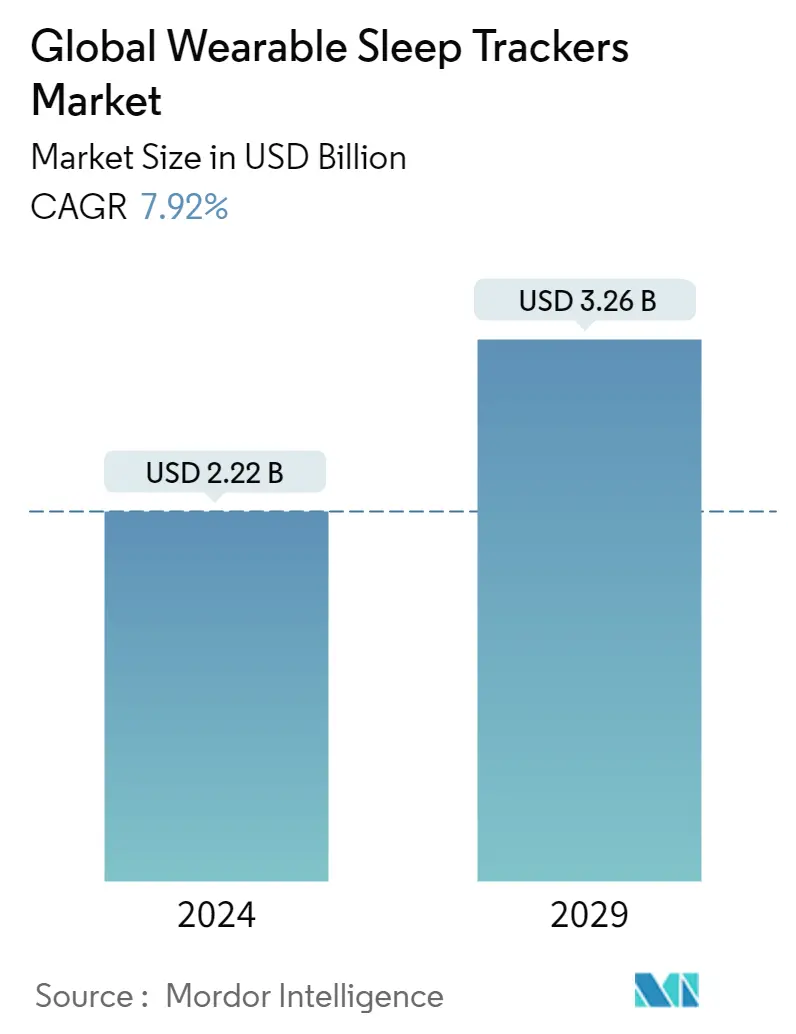Market Size of Global Wearable Sleep Trackers Industry

| Study Period | 2019 - 2029 |
| Market Size (2024) | USD 2.22 Billion |
| Market Size (2029) | USD 3.26 Billion |
| CAGR (2024 - 2029) | 7.92 % |
| Fastest Growing Market | Asia-Pacific |
| Largest Market | North America |
Major Players*Disclaimer: Major Players sorted in no particular order |
Need a report that reflects how COVID-19 has impacted this market and its growth?
Wearable Sleep Trackers Market Analysis
The Global Wearable Sleep Trackers Market size is estimated at USD 2.22 billion in 2024, and is expected to reach USD 3.26 billion by 2029, growing at a CAGR of 7.92% during the forecast period (2024-2029).
Unprecedented changes have occurred in people's lives as a result of the COVID-19 epidemic. For a lot of people, it has resulted in a lot of worry, anxiety, and worries about their health, social isolation, job, finances, and the difficulty of juggling work and family responsibilities. Sleep disruption and market growth are likely consequences of such a momentous life event. According to the study titled "Increased sleep duration and delayed sleep timing during the COVID-19 pandemic" Scientific Reports in July 2022, for 32% of users overall during the pandemic's acute phase, weekday sleep length increased by more than 20 minutes, while 17% of users reported sleeping less than normal. In addition, nearly all nations experienced considerable changes in sleep schedules in the second quarter (April to June) of 2020, just after the World Health Organization declared COVID-19. Thus, all people in every nation around the globe experienced changes in their sleep patterns during COVID-19, which had a substantial impact on the expansion of the market for sleep tracking devices.
The major factor attributing to the growth of the market is the rising incidence of sleep disorders like sleep apnea, insomnia, and narcolepsy globally. Therefore, the increasing variety of different types of wearable sleep trackers is expected to provide better and healthy sleep to people suffering from these disorders. According to the study titled "Prevalent, incident, and persistent insomnia in a population-based cohort tested before (2018) and during the first wave of COVID-19 pandemic (2020)" published in the Sleep in January 2022, Between 2018 and 2020, the prevalence of insomnia grew by 26.7%, from 25.4% to 32.2% (symptoms), and from 16.8% to 19% (syndrome). Thus, growing prevalence of insomnia across the globe the demand for sleep trackers is expected to increase to monitor the overall sleep performance, thereby boosting the market growth.
Health awareness, technological advancements, new product launches, and increasing research and development activities across the globe boost the market growth. For instance, in August 2021, Muse unveiled Muse S, the updated version of their well-liked EEG meditation and sleep headband. This improved plush brain-sensing headband uses real-time biofeedback to help people learn the art of meditation, fall asleep, stay asleep, and now go back to sleep if they wake up in the middle of the night. Thus, the growing prevalence of sleep disorders and product launches by the key market players support the market growth. However, the high cost of devices and increasing demand for nonwearable device trackers restrain the market growth.
